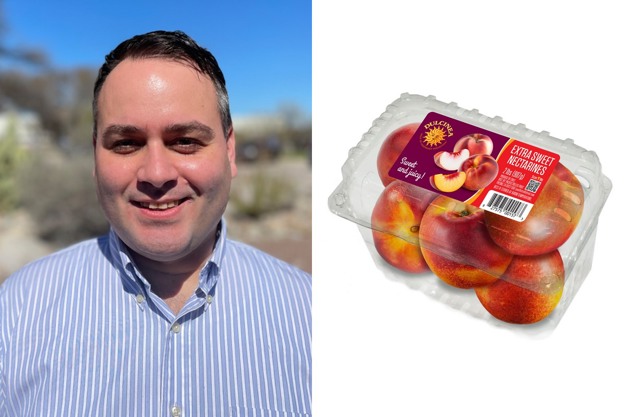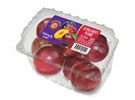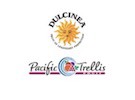Supplies of imported stone fruit are extremely light. “We’re seeing a major delay in the south of Chile on all items,” says Dan Carapella Jr. of Pacific Trellis Fruit, noting that this means there’s an extended window for air fruit this year due to the lack of vessel availability and transit times. “We’re likely looking at a compressed season once the fruit does start coming in towards the end of this month and through February in volume. We will see what the season brings once the volume starts coming.”
Historically, the first peaches would start coming in with consistent volumes by the first week of January with nectarines a week or two later and plums typically three to four weeks later. Promotable volumes normally would arrive in late January or early February. “This season it looks like in late January-early February we’re just going to be catching up to where we normally are at the beginning of the month,” says Carapella Jr. “We’ll likely not see consistent vessel plums until week 6 or 7 which is also late.”
Meanwhile, South Africa has increased its plum programs to the U.S. “What started two seasons ago as a test as to whether there was a market for their product--which does have higher labor and production costs as well as longer transit times than Chile--has been met with success,” says Carapella Jr. While the program grew slightly last year, this year it’s significantly expanding. These plums will likely be available in week 5 and will start with the Ruby Sun variety.
 Left: Dan Carapella Jr.; right: Extra Sweet Nectarines.
Left: Dan Carapella Jr.; right: Extra Sweet Nectarines.
Shifting markets
At the same time, as has been seen with Chilean cherries, Chile’s stone fruit is shifting more towards shipping to China rather than North America. “Up until this year, it was very limited as to what peaches could be exported to China and the growers were not seeing the return on investment because they had limited export markets, older varieties and limited productions,” says Carapella Jr. A lot of what was put in place were nectarines, particularly white-fleshed varieties, that are preferred in China. (The North American market tends to prefer yellow-fleshed varieties, likely influenced by the domestic production of this fruit.)
“This is causing an interesting dynamic in marketing because retailers want to keep their display sets such as they are during the domestic season. The industry needs to consider import stone fruit sets completely separately from domestic stone fruit sets to be successful at this time of year because the availability doesn’t match with the domestic season,” says Carapella Jr. On top of that, a few seasons ago some lower-production plum varieties were removed due to unsustainable grower returns, such as the Friar. “At this point, there are very rarely consistent volumes of red and black plums in the market from Chile at the same time anymore,” says Carapella Jr., noting that the retailers who want to carry both on the shelf sometimes struggle to find both while others have shifted to just carrying “plums” rather than the “either/or” option and some have removed winter stone fruit from their displays completely. He does note that a lot of what South Africa offers is counter to what Chile brings in which helps the balance.
 To help offer a consistent supply of quality stone fruit, Pacific Trellis began an extra sweet plum program which is part of its premium and specialty clamshell stone fruit category. Last year the extra sweet plums were introduced--a mixed variety with brix of 14 and higher, along with varieties such as lemon plums, watermelon plums and sugar plums. “We started selling straight loads of these off ad which is very interesting--I’ve never seen that before and that proved that if the consumer was getting a good piece of stone fruit that they enjoyed eating, they’d buy it repeatedly.” This year donut peaches and extra sweet nectarines have been added to the program.
To help offer a consistent supply of quality stone fruit, Pacific Trellis began an extra sweet plum program which is part of its premium and specialty clamshell stone fruit category. Last year the extra sweet plums were introduced--a mixed variety with brix of 14 and higher, along with varieties such as lemon plums, watermelon plums and sugar plums. “We started selling straight loads of these off ad which is very interesting--I’ve never seen that before and that proved that if the consumer was getting a good piece of stone fruit that they enjoyed eating, they’d buy it repeatedly.” This year donut peaches and extra sweet nectarines have been added to the program.
Right: Extra Sweet Plums
Strong stone fruit demand
As for demand, it’s very strong right now though that’s largely caused by a lack of supply. More traditional demand will likely settle in mid-February once the pipeline is filled.
On pricing, peaches and nectarines are about $4 higher than this time last year while plums are $8-$10 higher. Looking ahead, peach supply will remain limited all season and pricing may ease off a few dollars but it will likely stay higher than historical for the rest of the year. Nectarine pricing will likely come off as volume arrives--mid-February-- and then they should see more historical pricing. “Plums for the last two years have seen demand exceed supply so I see plum pricing staying high all year,” adds Carapella Jr. “It’s nothing to do with production but instead the eating quality of the fruit and consumers buying it due to the favorable experience.”
 For more information:
For more information:
Howard Nager
Pacific Trellis Fruit
hnager@pacifictrellisfruit.com
https://www.pacifictrellisfruit.com/
